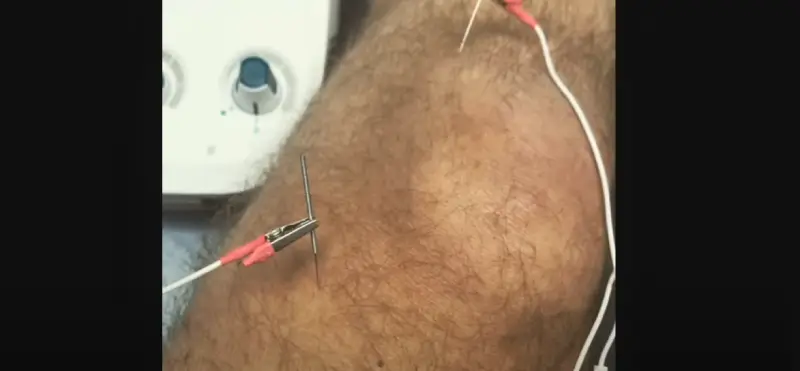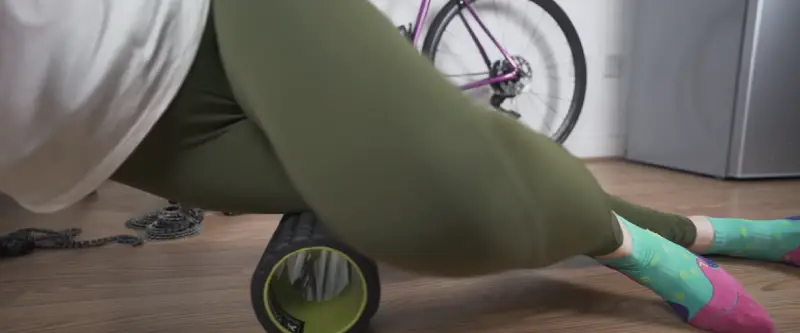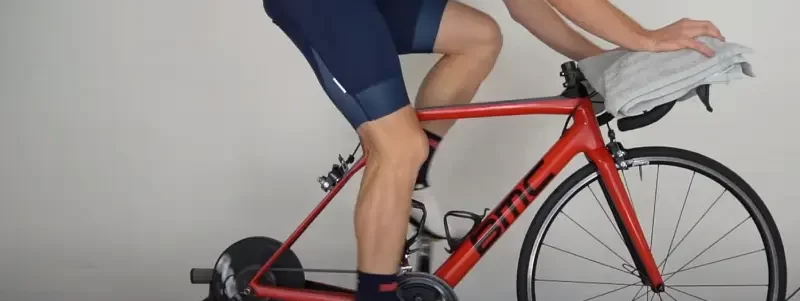Tendonitis in the knee for cyclists is often Patella Tendinopathy, causing pain and inflammation in the front of the knee because of overuse of the patellar tendon. This condition is common among cyclists when the patellar tendon is strained from being in the wrong position.
The best treatment for knee tendonitis in cyclists is to apply ice, consider anti-inflammatory drugs, and reduce cycling activity during treatment.
To maintain fitness, try low-impact swimming. Try acupuncture, EMS therapy, or cryotherapy for long-term relief from inflammation around the patellar tendon.
This blog post will discuss natural remedies and effective solutions for treating tendonitis in cyclist’s knees.
How to Treat Tendonitis in Knee for Cyclists: Top 6 Tools

Cycling offers excellent cardio and outdoor enjoyment. Repetitive knee strain is a common problem among cyclists, leading to tendonitis. Natural remedies can ease the pain and help you return to cycling faster. Nature offers gentle yet effective solutions for soothing tendonitis, allowing you to pedal with less discomfort.
Compression
Compression gear becomes an indispensable part of the recovery toolkit for cyclists battling knee tendonitis.
- Supports the knee: Cyclist-specific compression gear is designed to fit snugly around the knee, providing the support necessary to ease pain during and after rides.
- Reduces swelling: Compression gear is critical in limiting inflammation, making it a must-have for cyclists on the road to recovery.
Icing Your Knee for Tendonitis
Optimal ice therapy is essential for cyclists looking to reduce inflammation and manage pain effectively.
- Short and sweet: Applying ice for 15-20 minutes ensures that cyclists avoid skin damage while gaining the anti-inflammatory benefits.
- Regular intervals: For cyclists, repeating the icing process every 2 hours is crucial in controlling inflammation, especially after long rides.
Strengthening Knee Tendons
Exercises that strengthen knee muscles can prevent and treat tendonitis. Specific exercises can also strengthen knee tendons and support cycling performance.
- Essential Exercises: Focus on exercises like leg lifts, squats, and calf raises. These target the muscles that support the knee.
- Incorporating Exercises into Your Routine: Aim to include these exercises in your workout routine 3-4 times a week.
- Progression Tips: Start with low-intensity exercises and gradually increase the intensity. Avoid overdoing it to prevent further injury.
Herbal and Over-The-Counter Anti-Inflammatory Solutions for Cyclists
When choosing between nature’s remedies and pharmacy options, cyclists have various tools for their healing journey.
Nature’s Pharmacy for Cyclists
- Turmeric: A staple in a cyclist’s diet, turmeric contains curcumin, a compound celebrated for its anti-inflammatory properties. It helps soothe sore knees.
- Ginger: Another potent natural anti-inflammatory, ginger can be easily incorporated into a cyclist’s nutrition plan, whether as a tea or a supplement.
Drugstore Aisle for Cyclists
- Ibuprofen: A common choice among cyclists for reducing pain and inflammation, available over the counter for quick relief.
- Aspirin: Aspirin is not just for headaches; it also offers anti-inflammatory benefits that can aid cyclists in managing tendonitis pain.
Knee Tendonitis Treatment for Cyclists: 9 Solutions Strategies

Cyclists often experience knee tendonitis because of repetitive motion and strain. Here are several treatment and management strategies to help ease this condition.
Acupuncture
An acupuncturist strategically places fine needles at precise points on the body to ease pain and facilitate the body’s natural healing process.
- Overview of Acupuncture: Acupuncture can help reduce inflammation and pain associated with knee tendonitis.
- Benefits and Expectations: You might feel slightly tingling or warmth during a session. Many people find significant pain relief after a few sessions.
EMS Therapy
Electrical Muscle Stimulation (EMS) therapy uses electrical impulses to stimulate muscle contractions.
- Explanation of EMS: EMS helps improve blood flow and reduces pain in the affected area.
- Benefits of EMS: It can speed up recovery by building up the muscles around your knee without putting stress on the tendon.
Cryotherapy
Cryotherapy involves using cold temperatures to reduce inflammation and pain.
- Introduction to Cryotherapy: This treatment can be done at home with ice packs or professionally with specialized equipment.
- Effective Use: Apply cold packs for 10-15 minutes several times daily to help manage symptoms.
Rest and Recovery
Your knee requires time to heal and recover from tendonitis.
- Importance of Rest: Rest reduces strain on your tendon, preventing further damage.
- Balancing Fitness: Light activities like swimming can help maintain fitness without stressing your knee.
Adjusting Your Bike and Riding Habits
Proper bike setup and riding techniques can prevent knee tendonitis.
- Bike Setup: Ensure your bike fits you well. Adjust the seat height and position to avoid strain on your knees.
- Riding Tips: Keep a steady pace and avoid sudden increases in intensity. Warm up before riding and cool down afterward.
Foam Rolling for Anterior Knee Pain

Foam rolling is a self-massage technique to help ease knee pain.
- Benefits of Foam Rolling: It helps to release muscle tension and improve blood flow.
- Techniques: Roll gently over the front of your thigh, focusing on sore spots for about 30 seconds each.
Counterforce Bracing or Taping
Braces and tape can support and reduce strain on your tendon.
- Comparison: Counterforce braces disperse pressure while taping offers targeted support.
- Guidelines: Consult a professional to choose the right brace or tape method and learn how to apply them correctly.
Surgical Considerations
Surgical treatment could be an option for severe knee tendonitis.
- Overview of Surgical Options: Procedures like tendon repair or debridement can be considered if other treatments fail.
- Factors to Consider: Surgery requires recovery time and physical therapy post-operation.
Routine Checks and Balances
Regular monitoring of your knee health can prevent tendonitis from returning.
- Regular Check-Ups: Visit your healthcare provider to track your progress and adjust your treatment plan.
- Tips for Monitoring: Keep a pain diary and note any changes or improvements in your symptoms.
Conclusion
Knee health is relatively easy to maintain as a cyclist. You can prevent tendonitis and keep those knees strong by incorporating the right practices, such as adequate rest, proper bike adjustments, and targeted exercises.
Remember, it’s all about balance and listening to your body. If you ever find the pain persisting or worsening, seek professional medical advice. Early detection of knee pain can make a big difference, allowing you to continue cycling without the discomfort of knee pain. Keep those wheels spinning smoothly.
FAQs
Does Cycling Cause Knee Tendonitis?
Cycling can cause knee tendonitis, particularly Patella Tendinopathy when the patellar tendon is overused in an incorrect position. To reduce the risk, cycling slowly can decrease strain on the patellar tendon, making it safer for cyclists with knee problems. Consistent pedaling without abrupt stops can also aid in preventing knee tendonitis.
How To Treat Tendonitis In The Knee Naturally?
You can treat tendinitis at home by resting, applying ice, applying compression, and elevating the affected area. Treatment can speed up recovery and prevent further problems from occurring. Get some rest. Do nothing that will increase the pain or swelling.


